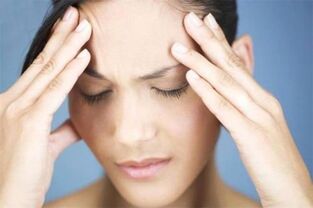Going upright frees one's hand to perform labor activities - this is a sure plus. With that, the load on the spine increases, leading to the development of serious diseases, and this is a major minus. Bone tumor is one of the most common diseases of the spine. It affects 60% of the world's population aged 35 and over. Surgical interventions are one of the treatments, but they can be replaced during the early stages of disease development. You can treat osteonecrosis at home. The range of effective remedies is extensive and affordable.
What isosteonecrosis
Dysfunction and destruction of the disc, vertebral tissue is a pathology of the musculoskeletal system, which is called necrosis of the bones. Osteocytes are bone cells, and chondrocytes are cartilage cells. Based on these names, the origin of the term "osteochondrosis" is clear. Degenerative-dystrophic changes in the spine negatively affect the general condition of the body.
As the disease progresses, muscle atrophy, nerve impulse conduction is interrupted, physiological system and individual internal organs become disturbed. Pain in the back and neck is the first sign of illness. Depending on the location of the focal point of injury, osteonecrosis is:
- Main symptoms: pain in the shoulder, arms, neck; dizziness, tinnitus, pre-eye spot.
- Characterized by dull pain or low back pain in the chest area.
- Appearance of pain in the hip, lower back, sacrum. The function of the lower extremities is limited.
- It grows in several parts of the spine at the same time. It is accompanied by intense pain.
Can effectively treat osteonecrosis at home with timely diagnosis. It goes through 4 degrees (or stages):
- The pathological process begins with dehydration of the central part of the disc (myeloid nucleus). As a result, the structure subsides, cracks appear in the outer part of the disc (annulus fibrosus). At this stage, the patient is hardly seen. Mild discomfort manifests itself in an uncomfortable position or during active physical activity.
- The spacing between adjacent vertebrae is reduced due to disc settlement. Ligaments and muscles sagging. The vertebrae have additional mobility. For this reason, they were displaced. This condition is called spondylolisthesis. With a strong load, the patient feels discomfort, sometimes pain in the area of the pathology.
- The formation of prolapsed (herniated), concave (uneven concave) masses of the disc, the disc drive and the joint degeneration of the disc are major pathological changes in the third stage ofsick. The patient's movements are limited, the appearance of numbness and tingling in the extremities. Available rashes, their localization depends on the location of the focus of the disease.
- To eliminate excessive mobility of vertebrae, the body forms tumors of bone tissue (bone-forming substance) in the spine. Their formation takes place in chaos, depending on where they can damage the nerve ends of the spinal cord, neighboring vertebrae. Significant structural changes (fibrosis) begin at the disc joints. The vertebral movement looks like "baffled". Signs of osteonecrosis at this stage are practically not felt.
How to treat genital warts at home. How to first aid at home?
Home treatment for fibroids includes:
Drugs- ;
- physiotherapy;
- massage;
- medical gymnastics;
- adjust the diet.
The combination of therapies helps to achieve good results in the treatment of cervical fibroids. Symptoms can be very uncomfortable, so it's important to know first aid.
Medicines
Various drugs are used to combat the symptoms of the disease. They should be prescribed by a doctor who specializes in treating osteonecrosis - a neurologist or a spine specialist.
Medicines

- For severe pain you can take a pain reliever like metamizole sodium. If they don't work, NSAIDs can be used.
- Sometimes use "distraction", such as pepper paste. It does not heal itself, but heats the inflamed area and relieves pain.
- Herbal infusions and diuretics are useful for edema in inflammatory areas.
The following classes of drugs are prescribed to treat SHS:
- Nonsteroidal anti-inflammatory drugs (Nimesulide, Ketoprofen, Meloxicam, Diclofenac and others). They help relieve pain, swelling and inflammation of the affected nerve roots.
- B vitamins. They help improve metabolism in nerve tissues.
- Chondroprotectors. Promotes cartilage tissue recovery.
- Muscle relaxants (tizanidine, tolperisone hydrochloride). Helps reduce muscle spasm.
- Drug intended to improve the rheological properties of blood and blood. They help improve blood circulation to the brain and the nutrition of the nerve endings affected.
can also be specified intramuscularly.
How to treat cervical and thoracic spine tumors at home. Overview of home remedies
U neck and chest spine, if ignored will lead to disability. Pathological signs:
- pain in affected area (neck, chest) with light exertion, sudden movement;
- headache;
- dizziness;
- shortness of breath and shortness of breath;
- is tired.
If you experience alarming symptoms, you need to see your doctor for further diagnosis. If the diagnosis is confirmed, the doctor will determine the stage and prescribe treatment.
Treatment of bone necrosis of the chest and neck with conservative and surgical techniques. At home, you can cope with treatment in your first and second stages of development. With worsening of the condition, even greater migration of the vertebrae, their fusion, defects are eliminated during the operation.
Treatment of neck and chest bone tumors at home is carried out with the help of pharmaceutical preparations, a complex of gentle exercises, folk formulas for massage and compresses. Doctors recommend visiting swimming pools, massage therapists, physiotherapy rooms. Actions to reduce symptoms:
muscle relaxant- ;
- stimulates the cartilage layers to regenerate;
- returns the displaced vertebrae to their original position;
- releases pinched nerve fibers.
Home treatment of spinal and thoracic degeneration will be effective if all the recommendations of your doctor are followed.
Medicinal preparations
Cervical and thoracic fibroids can be treated at home with the help of medications - drugs are usually available, easy to buy at pharmacies. Do not conduct treatment without the prescription of a doctor, wrong treatment will slow down the healing process. It is impossible to predict the body's response to the drug. They stop pain in the affected area, decrease muscle tone, increase blood circulation, improve metabolic processes and improve health.
Drugs that slow progression.
Medicines prescribed at home for the treatment of neoplasms of the neck and chest in the chest and neck area:
- Nonsteroidal anti-inflammatory drugs that help eliminate inflammation and edema at home. After the procedure is complete, the pressure on the spinal artery and the blood vessels in the spine is reduced.
- The pain reliever quickly gets rid of the sensation of pain and nerve tension.
- Relaxing medicine - a medicine that relaxes muscle tissue, relieves pain.
- Preparations based on chondroprotectors for bone destruction in the thoracic and cervical spine normalize metabolic processes in the cartilaginous and skeletal tissues of the spine. Thanks to that, it is possible to stimulate regenerative properties of tissues, increase the distance between the vertebrae, help deformed parts to the desired positions. Under the influence of chondroprotectors, the pain is often less manifest.
- Vasodilators help improve blood flow to the site of injury. As a result of the enhancement of nutrition, the manifestation of symptoms is reduced, the adjustment process is accelerated.
- Vitamins are helpful assistants in the treatment of osteonecrosis at home. Receive groups B, C, E to provide the body with the necessary substances for the fight. They stimulate cartilage tissue healing, strengthen the spine and improve the permeability of nerve fibers.
How to treat osteonecrosis and myositis at home. The main goals of home treatment
The doctor decides to treat cervical fibroids at home if the patient does not have serious disorders, has moderate symptoms and does not require hospitalization. The chosen therapeutic strategies aim to eliminate bothersome manifestations of the pathological process and address the following tasks:
- Normalizes blood circulation in the affected area.
- Eliminates cerebral hypoxia.
- Standardize sleep mode.
- Prevents the rapid development of the disease.
- Improves blood circulation.
- Starts regenerative processes for the restoration of cartilage tissue.
- Saturates the body with vitamins and minerals.
- Eliminate anxiety, panic attacks, irritability.
- Improves condition of cervical furrows.
There's absolutely no cure for chondation, but the right approach can significantly slow down the process, restore normal health and maintain a high quality of life for many years. For this, an integrated approach is used, which implies changing the diet, increasing physical activity, taking medication, and seeing a massage therapist.
Cervical fibroids can only be cured at home by strictly following all the doctor's recommendations, constantly monitoring nutrition and taking medications, and performing exercise exercises. value according to regulations.
Treatment for cervical fibrosis should be initiated by eliminating pain. For this, the specialist selects the right pain reliever medications. The pharmaceutical industry offers a wide variety of products that vary in principle of operation, form and price. With intolerable acute pain, novocaine blockade is possible. Once the main symptom has relieved, alternative techniques can be used. It could be:
- Massage process - eliminates spasm, pain and tension.
- Exercise therapy - strengthens muscle tissue, restores the normal support of the spine and restores its flexibility.
- Mud bath - warms the affected area and relieves pain syndrome for a long time.
- Manual therapy - restores metabolism and improves blood flow, eliminates oxygen starvation of the brain.
- Acupressure - relieves pain in that area, initiates regeneration in the cartilage tissue.
- Acupuncture - activates metabolism, improves the condition of cartilage tissue, reduces the expression of painful sensations in the affected area.
The most appropriate home treatments are ointment, massage, bath, sharpening, and compress. Such traditional medicines have long been known and are well known for their safety, ease of use, and few contraindications.
Home remedy for degenerative vertebrae at home. Symptoms of the disease
Neck spine cyst in the early stage may not appear in any way. The accompanying signs appear only in the case of a progressive form of pathology, when there is a violation of blood circulation in the brain. This process is usually accompanied by:
- dizziness;
- numbness of the limbs;
- with cold hands and feet;
- "goosebumps" in the eyes, blurred;
- headache;
- noise in the head, tinnitus;
- increased fatigue;
- annoyed;
- lacks coordination;
- unstable gait;
- tingling, tingling in the neck muscles.

If the disease is in a chronic form, the patient will experience constant discomfort and pain. Main expressions:
- pain sensation in the back of head, neck, shoulders, arms, difficulty moving head, creaking when turning or bending;
- pulled pain in the left chest when irradiated to the left arm, a burning sensation between the shoulder blades;
- frequent headache, increased fatigue, weakness, difficulty turning;
- pain in the neck extending to the shoulders and arms, numbness in the fingers;
- may experience impaired hearing and vision, numbness of the tongue and face, dizziness, impaired lung and heart function.
Symptoms are divided into three groups:
- neurological manifestations (constant neck pain, muscle pain, chest, joint pain);
- pathological effects on the spinal cord (weakness of the arms and legs, involuntary convulsions, myelopathy);
- refers to processes that occur in the brain (brain manifestations due to insufficient blood supply: visual disturbances, sensation of foreign bodies in the throat, noise and tinnitus, hearing loss, dizzinessface, unsteady walking, fainting, fatigue, irritability, sleep disturbance, memory loss).







































